Securing the toilet lid: how to remove the old and install a new seat on the toilet
To make the daily operation of the toilet comfortable, a special pad is used - the seat. And most of them are equipped with a lid. It is with the breakdown of the latter that one most often has to face. Agree, not much is pleasant in the broken fasteners.
But even the usual fastening of the toilet lid often causes people questions. No wonder, considering that depending on the model, the fasteners and configuration of the toilet lids differ dramatically.
Do not call the plumbing because of such a trifle? Do you want to replace the seat with your own hands, but are afraid of inexperience to break a new one? We will help you deal with the secrets of installing a new seat - the article discusses the basic design of the toilet seats and their features.
Detailed instructions are also provided for securing the hinged lid and models equipped with a micro-lift. For a better understanding of the replacement process, the material in our article is supplemented by visual photos and a video showing the installation of a seat with a micro-lift.
The content of the article:
Constructive design of a toilet seat with a cover
A sanitary appliance, which is an integral part of the toilet of modern housing, is called a toilet. The device itself is quite simple, quite understandable to a person inexperienced in plumbing.
Models of toilets of modern production are designs that mounted on the wall (outboard) or mounted on the floor (floor).
You may be interested in subtlety information. choice of toilet with installationdiscussed in detail in another article.
In turn, floor-mounted plumbing is additionally divided by type:
- toilet bowls complete with a tank;
- tank and bowl as separate components;
- appliances that fit snugly against the wall.
The materials for the manufacture of plumbing are porcelain or earthenware. In terms of performance, faience is inferior to porcelain.
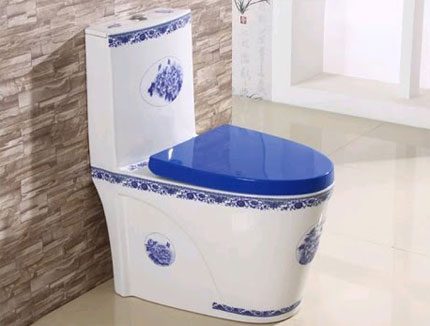
The flush toilet system operates on the basis of a manual button control. There are also models where the drain process is electronically controlled.
According to standards, the height from the floor to the top of the appliance lid should be 400 mm. The parameter for static load is 200 kg. This information can come in handy when it comes time to engage in mounting for home toilet seats.
You may also find the toilet size information discussed in our other article.
For modern models toilet seats with lids They are made, as a rule, on the basis of plastic (duroplast, polypropylene, thermodure, supralit, etc.).
This material is considered to be positively hygienic and therefore welcomed as optimal, despite the rather weak load properties. True, the properties of the toilet seat largely depend on the quality of the plastic structure, as well as on the design features of the fixing system.
Toilets can be considered universal products, because in most cases, due to their compatibility, questions arise: how to remove a broken seat from the toilet and how to install a new seat on the toilet.
In addition, it is possible to select toilet seats during the replacement process:
- soft
- semi-rigid;
- hard.
In this case, the fasteners from the seat kit can be plastic or metal. By design, the fasteners are made different in shape and size.
But in general, the principle of fastening remains the same, despite the variety of models.
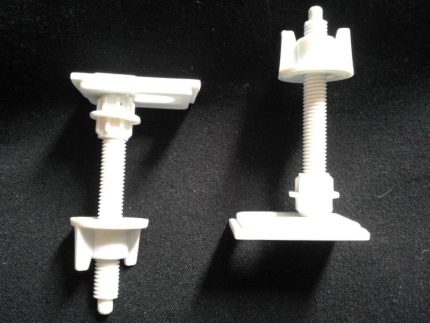
Saddle covers on modern toilets are represented by an impressive constructive variety of movement mechanisms. Variations - from the simplest articulated mechanisms to mechanics such as "Soft-closing" and electronic bidet covers with presence sensors.
Depending on the specific model, there is a chance to encounter such fasteners for the toilet seat when you can not do without a careful study of the design features.
The procedure for removing the usual toilet seat is simple:
- Raise the toilet lid (the toilet seat remains lowered).
- Unscrew the fastening nut from the bottom left under the rear porcelain edge.
- Perform the same operation on the right side.
- Remove a toilet seat from the toilet.
Plastic nuts are usually freely loosened by hand. By the way, tightening such accessories strongly is not recommended, since the plastic bolts simply break off from the constriction.
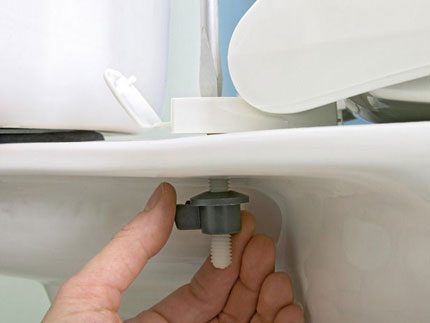
Installing a new cover is done in the same way. The holes on the cover must be combined with the holes on the rear edge of the plumbing, insert the mounting bolts into the mounting holes and screw the nuts on them from the bottom.
There are accessories with washers and without washers. For the “without washers” configuration, universal nuts are made in which one of the end edges has a washer shape.
Often you can find the option of fasteners for the toilet seat: a metal bolt - a nylon nut. This tandem gives a more reliable grip.
Type # 1 - Swivel Mechanisms
Household toilets are usually equipped with toilet seats, the covers of which are mounted on plastic, metal-plastic, metal hinges. The design of a dynamic mechanism on a plastic joint is most common.
On the one hand, the plastic version is good in terms of the absence of corrosion effects on the connection elements.But in terms of reliability, plastic hinges are inferior to metal products.
Plastic fittings have to be changed more often. As a rule, seats from an assortment of inexpensive products are equipped with hinges on plastic. Metal hinges are often a component of a perfect rotary mechanism - a microlift.
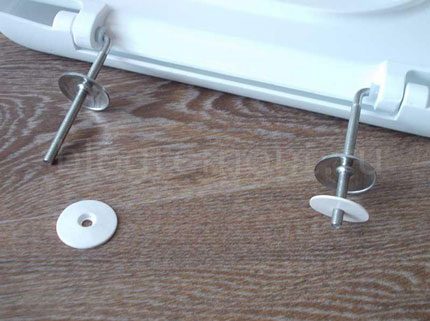
Dismantling plastic hinges may be required, for example, in case of damage to the cover and the need to replace it with a new one. There is no need to remove the general fastening of the toilet lid, just remove the hinge shafts.
There are lots of manufacturers constructive solutions for fixing the shafts in the landing groove. The simplest solution is to have a locking pin at one end of the shaft. It is necessary to tighten the pin and pull the shaft out of the bore of the hinge.
Often there are locks that remove the lock by turning them 90-180 degrees counterclockwise. There are also shaft clamps with screws and screws.
Installation on the toilet seat with one of the simplest hinge designs:
- Align the openings of the toilet seat ears and the cover.
- Insert the nylon sleeve into the hole on the inside of the toilet seat.
- Place the end of the metal stud inside the nylon bush.
- Do the same on the opposite joint.
- String decorative washers and gaskets onto the studs.
- Place the entire structure on the toilet by inserting the studs into the mounting holes.
The procedure ends with fixing by screwing the nuts onto the studs from the bottom of the toilet edge.
A short photo course will clearly familiarize you with the installation procedure and the standard sequence of actions for fastening the lid for the toilet:
Type # 2 - devices of the micro-elevator series
Increasingly, plumbing for the toilet appears on the market, equipped with seats, the lid of which is set in motion by a "landing in place" semi-automatic mechanism - a micro-lift.
How to install a seat with a lift on the toilet? Just like a standard toilet seat. The mounting scheme is practically no different.But the hinge mechanism of such a model has some features that will have to be taken into account in case of repair.
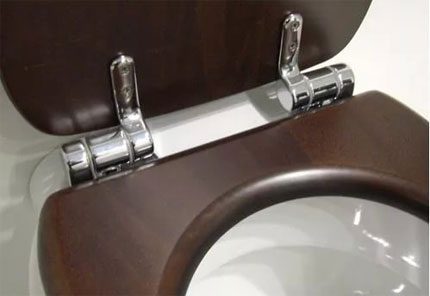
The mechanics of the micro-lift are built on the following details:
- stock;
- spring;
- piston;
- cylinder.
Usually, the wear of any of these elements or a breakdown causes the toilet seat to be removed in order to install a new one. Repairing a lift is quite difficult for people without relevant experience.
Meanwhile, a common cause of microlift failure is the banal “descent” of lubricant from the surface of the piston cylinders. Such a defect appears as a result of forced pressure on the cover by the users themselves - an attempt to forcefully lower the seat.
If desired, some designs of lifts can be disassembled and try to restore a uniform distribution of damper lubricant over the entire surface of the cylinder.
You may be interested in information on how to fix the toilet lid.
But for most owners, it’s easier to buy a new seat cover with a micro-lift. You can also try to order a separate microlift system from the manufacturer for a specific toilet model.
The installation kit usually contains two studs with patch-pads, two gaskets, two nuts and two micro-lifts.
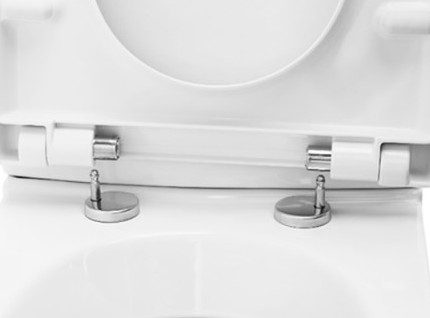
To install a new seat with a lift on the toilet body, the following actions are performed (one of the existing options):
- to put micro-lifts on the pins of the patch sites;
- put the toilet seat cover with the top side on the floor;
- insert the microlift bushings into the holes of the hinged ears;
- left lifter on the left (mark L), right on the right (mark R);
- on the trailing edge of the toilet bowl, over the existing holes, lay gaskets;
- install the seat with the lift on the toilet by inserting the studs into the holes;
- fix the entire structure from below with the nuts from the kit.
There are developments, for example, of the well-known company Roca, where micro-lifts are rigidly fixed to the seat body. The user at the time of installation of the seat only needs to insert the brackets into the mounting holes of the toilet bowl, wrap them with the hex wrench included in the kit.
Then pick up the seat and gently push it onto the tabs of the brackets with the holes that are on the bushings of the microlift mechanism. Finally fix the insert with screws.
Replacement Selection Criteria
If it so happened that the question arose of replacing the toilet seat pick up chair cover under existing plumbing. It is recommended to measure the plumbing fixture in terms of size and shape. The location of the mounting holes for the seat should also be clarified.
The size in width is measured at the points of greatest “take-off” of the structure. The length dimension is taken from the edge of the front of the curb to the point of the center line passing between the centers of the holes intended for fastening the toilet seat.
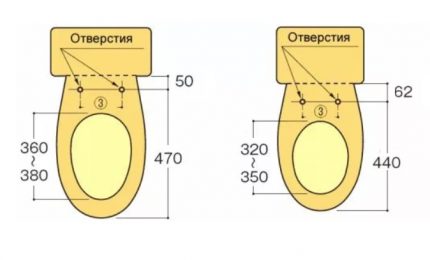
Often the owners of the toilet, which had to change the toilet seat, instead of the standard design prefer to choose more advanced models. This choice is explained by their desire for novelty.
Meanwhile, the new “heated”, “backlit”, “with motion sensors” in practice turn out to be even bigger problems.A serious manufacturer of sanitary ware is in no hurry to offer such an "exclusive" to the buyer. Such proposals come, as a rule, from Chinese firms.
Exclusive toilet seats
Plumbing fixtures for the toilet, equipped with electronics, have long been no surprise. Recently, toilet bowls have also come close to electronic fraternity. Regulators of discharge, water intake, disinfection, filtration - these functions become integral parts of bidets and urinals.
Some of these functions are also used on toilet seats. So quickly gaining popularity electronic bidet covers and heated seats.
Installing an electrical model is basically similar to installing in a standard variation. The only addition is laying the cable and installing an electrical outlet.
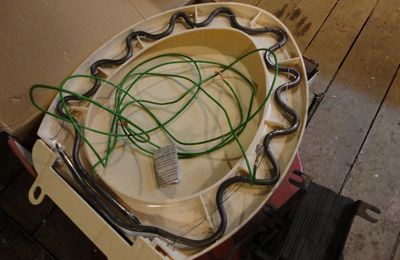
The design of the models with the backlight of the bowl is not entirely clear - what benefit do they bring to the visitor of the toilet? Nevertheless, these decisions remain relevant due to the stability of their demand in the market.
The installation of a backlit seat should include the installation of an electrical network in the toilet room. However, there are models of toilet seat covers where the backlight is powered by batteries.
Batteries are built directly into the seat structure. Do not do without the installation of electrical communications and in the case of the use of toilets with the function of motion control.
Problems Replacing a Seat
Some problems when replacing a toilet seat or lid may occur on plumbing fixtures that have served the owners for several years. Especially often, removing fasteners on an old toilet seat is complicated if metal bolts and nuts that are subject to corrosion were used.
A high level of humidity in the toilet area is created by the water present in the flushing tank. This is the main reason for the appearance of rust and oxides on the thread.
To unscrew the nuts from the fixing bolts in this state is extremely difficult, and sometimes impossible, by traditional methods. We have to resort to radical measures.
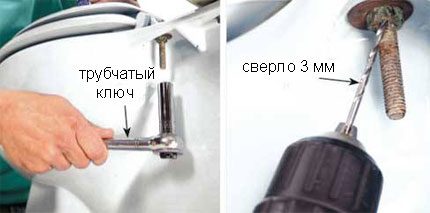
So, if the thread of a bolt or stud is damaged by corrosion and twisting the nut is not possible even with a wrench, the problem can still be solved.
Why do the following:
- Apply an electric drill.
- Insert a drill bit slightly smaller than the nut wall thickness into the drill chuck.
- Carefully drill the nut from its lower edge to the upper.
- Insert a suitable metal rod into the hole.
- By swinging rod efforts, try to “break” the nut.
Sometimes a similar situation appears on plastic fittings. It happens that during installation (during cleaning) the threaded part of the stud is accidentally damaged. A defect in the plastic thread will also prevent the seat mounting from being removed in the usual way.
If you can’t twist the nuts with a tool, you can cut them with a sharp thin knife, preheating the blade of the knife to the melting temperature of the plastic (120-130º C).
Part of the seat mounting hardware with covers is made of brass and bronze. This metal is not susceptible to corrosion, but has the ability to oxidize rapidly in the presence of moisture. Oxides, in turn, form “growths” on the thread, which over time become comparable in hardness to the same metal.
To turn off such connections helps their preliminary wetting (and time delay) with engine oil. Lubricate the connection easily and conveniently with a plastic disposable syringe.
Conclusions and useful video on the topic
The installation video will help you cope faster with installing the seat on gas lifts.
A toilet bowl is a household plumbing fixture, the frequency of use of which is incomparable with the operation of other household accessories.
It is not surprising that many citizens are puzzled by the problem of removing one seat from the toilet and then replacing it with another. But this problem is solved and done, if desired, with your own hands..
Have you repeatedly changed the mount without changing the cover? Or do you prefer to buy a new seat instead of the old one with a breakdown? Or maybe you use one of the exclusive cover options - with a bidet function or with a backlight? Share your opinions and recommendations in the comments below.

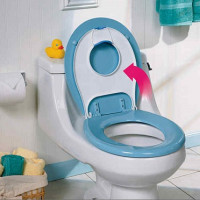 Seat toilet seat: types, selection rules and installation features
Seat toilet seat: types, selection rules and installation features 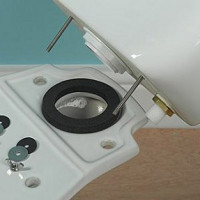 Replacing the toilet bowl: how to remove the old tank and put in a new one
Replacing the toilet bowl: how to remove the old tank and put in a new one 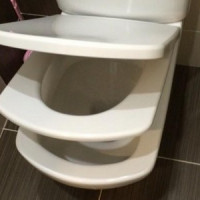 Repair of the toilet lid: frequent breakdowns and methods for their elimination
Repair of the toilet lid: frequent breakdowns and methods for their elimination 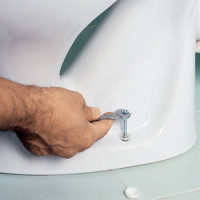 How to remove an old toilet: an overview of the technology for dismantling old plumbing
How to remove an old toilet: an overview of the technology for dismantling old plumbing 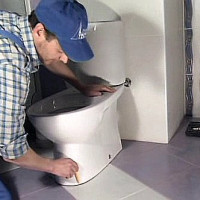 How to install a toilet on a tile with your own hands: step-by-step instruction + installation features
How to install a toilet on a tile with your own hands: step-by-step instruction + installation features 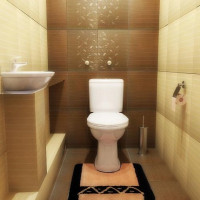 How to install a toilet with an oblique outlet: detailed technical instructions
How to install a toilet with an oblique outlet: detailed technical instructions  How much does it cost to connect gas to a private house: the price of organizing gas supply
How much does it cost to connect gas to a private house: the price of organizing gas supply  The best washing machines with dryer: model rating and customer tips
The best washing machines with dryer: model rating and customer tips  What is the color temperature of light and the nuances of choosing the temperature of the lamps to suit your needs
What is the color temperature of light and the nuances of choosing the temperature of the lamps to suit your needs  Replacement of a geyser in an apartment: replacement paperwork + basic norms and requirements
Replacement of a geyser in an apartment: replacement paperwork + basic norms and requirements
Carried with a new toilet lid for about 2 hours, it was not possible to attach it correctly. When I got acquainted with this information, everything fell into place, realized my mistakes, eliminated them. The first time I encounter a micro-lift system, this is a difficult installation work for me, because before that we had a regular plastic cover with the most usual principle of fastening.
Now there are many new models of toilets, but the principle of fixing the covers is the same everywhere. Everything is really simple, and everyone can handle it. It is necessary to lift the toilet lid and unscrew the fixing nut on both sides below the china edge. Then remove the bolts and remove the old cover. With the new, we do everything in the reverse order. Just do not need to tighten the nuts.
Your advice is urgently needed! If I already put the cover on these metal pins, can it be removed from them? Or will it fail without breaking the lid openings? Forgot to install decorative wheels ...